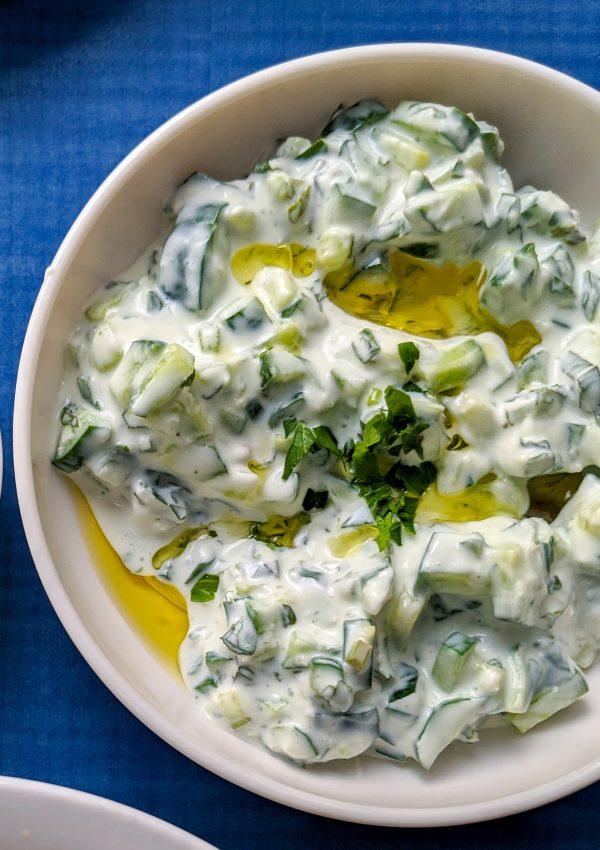
When I was little my family lived alongside a Lebanese family with whom we’ve since shared a lifelong friendship. Our families shared so many meals together, and celebrated together during holidays and special events. I have since always loved Lebanese foods and other foods originating from the Middle East and North Africa – the spices, colours and diversity in so many different flavourful recipes.
Okay, yes, I am aware that falafels are not Lebanese, but the love of spice medleys originated from my delight in Middle Eastern recipes that I had the pleasure of tasting as a kid. It’s said that falafels originated from Egypt (where fava beans were used, not chickpeas or lentils), and Israel has claimed the falafel to be a national food. In any case, I have always loved falafels… but they can be tricky.
First, many falafel recipes are not gluten-free, so I’ve created a gluten-free version that will be safe for all my GF foodies out there. Second, too many recipes call for legumes that are not properly cooked prior to adding them to the recipe itself. Which leads to my third point: they can cause some serious gas!
Falafels with a purpose
It IS possible to create falafels in such a way that is not only delicious, but isn’t a foul-smelling challenge to digest. Before I get into these tips and tricks, let me mention a few reasons why I love falafels.
- They are the perfect snack, and are a great addition to a meal (tired of your little can of tuna with your work lunch salad? Yeah, me too. Give the falafels a try.)
- They can be batch-cooked and will store easily in the freezer for months
- Falafels are full of plant-based protein and rich in fibre
- In the case of using lentils, these falafels are also low in carbohydrates and (almost) just as satisfying as eating a cookie (I did say almost… nothing beats a fresh home-baked cookie!)
Getting gassy, and the joys of using enzymes

Red lentils are perfect for anyone who has some difficulty in digestive legumes, because they don’t contain a type of sugar called an oligosaccharide. The human body does not produce any enzymes in our entire digestive tract to breakdown this kind of sugar, so it takes more effort for our digestive tract to break it down (eg. via acids, like our stomach’s hydrochloric acid, and mechanical digestion, a.k.a. chewing). As a result, bacteria living the high life in our colons will feed on these sugars, which causes fermentation and consequently, gas.
Of course, legumes are also very high in fibre, and if you increase your intake of dietary fibre you might notice, at least for a short period of time (2-8 weeks) that your body is producing more gas, possibly accompanied with some bloating. Also to note, legumes are not part of the Autoimmune Protocol (AIP), but if you are trying to test and potentially reintroduce legumes, I suggest starting with lentils.
Outside of the preparation of legumes, if you notice an increase in flatulence and/or bloating, I recommend assisting your gut by using a digestive enzyme with your meal. You’ll want to use a digestive enzyme formula that contains the alpha-galactosidase enzyme (derived from a fungus called Aspergillus niger) because it can break down the oligosaccharides that your body cannot do on its own. Here’s one digestive formula from Flora that I quite like, How to prepare lentils
As with all other legumes, I recommend soaking the lentils for at least 6 hours, or overnight, in water with 1tbsp of apple cider vinegar (ACV). Adding ACV can help to reduce the oligosaccharides, phytic acid and lectins produced by the lentils (and other beans), and to enhance the flavour of the legumes. It is normal for the lentils to sprout a little, and to double in size. Rinse the lentils thoroughly (watch for grains of sand or small rocks – no breaking teeth on my watch!), and then add the lentils to a pot with fresh water. You can add a little bit of ACV salt and oil if you would like, but it’s not necessary. Cook for an hour, and then strain of any excess water. If you have a pressure cooker, such as an Instapot, you can quickly and effectively cook your legumes. Pressure cookers help to break down some of the proteins like lectin that are difficult to digest and cause indigestion, gas and nutrient malabsorption. Another tip is to add a piece of kombu seaweed to the legumes while they cook. Kombu is a large seaweed that can neutralize some of these gas-producing compounds. You only need a small piece, and remove it from the pot before it gets too mushy while the lentils are cooking. Once cooled, add the lentils to a food processor and blend with all of the other ingredients. See the recipe below for all of the steps and ingredients. You may notice that many of the spices used are actually carminatives, which are plants (seeds, roots, etc) which assist in digestion and help to dispel gas, thereby reducing flatulence and bloating. Feel free to experiment with the ratios of spices used for your own tastebuds. Once out of the oven, wait until the falafels have completely cooled. You can easily stack them into a container with or without parchment paper. They should keep for 3-4 months before running the risk for freezer-burn. It will take about an hour or two for them to thaw, once out of the freezer (place them on a plate to speed things up, don’t leave them in the container). Harissa is a traditional paste or dried spice medley consisting of red peppers. Harissa can be mildly spicy or very spicy, depending on the type that you get (it should say so on the product description). I really like this brand, but please note that it is normally much less expensive at a regular grocery store, usually around the 7-10$ price range. The directions and ingredients quantities in the recipe below are approximative. You might find the need to adjust depending on your own personal preference, and if the medley is too dry or too wet. If you like crispy falafels, I recommend cutting down the baking time so that in the last five minutes you can turn on the Broil oven setting, and brush some fresh olive oil onto the falafels. This should do the trick! And now, the recipe. This recipe post is part of a larger meal assembly that I created for a Mediterranean-styled dinner. If you’d like to check out the other delicious recipes, visit my post “Dinner Among Friends and Spices.” Want a quick and easy dip to compliment the falafels? Try my vegan tzatziki dip! Looking to change up your typical salad routine? Try my gluten-free tabouleh salad. 
How to freeze the falafels, and other notes


Red lentil falafels
Equipment
Ingredients
Instructions












